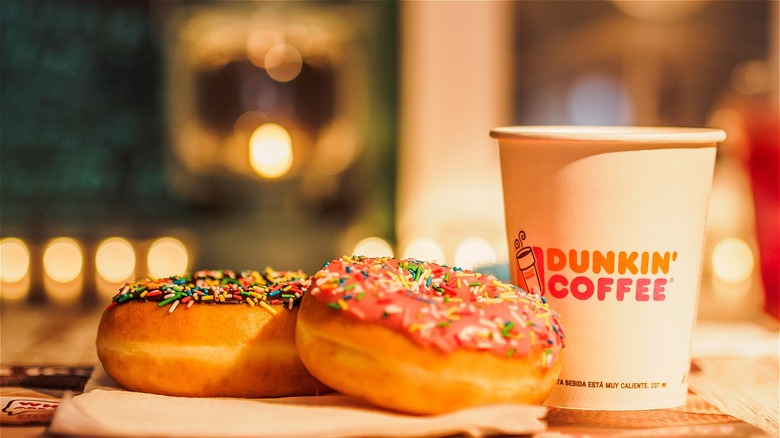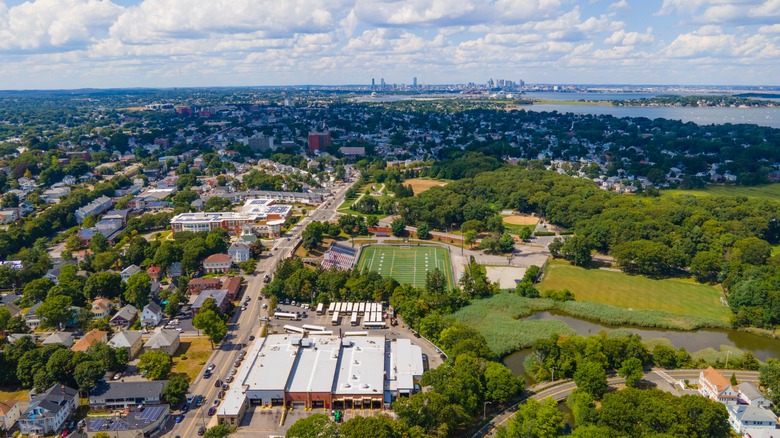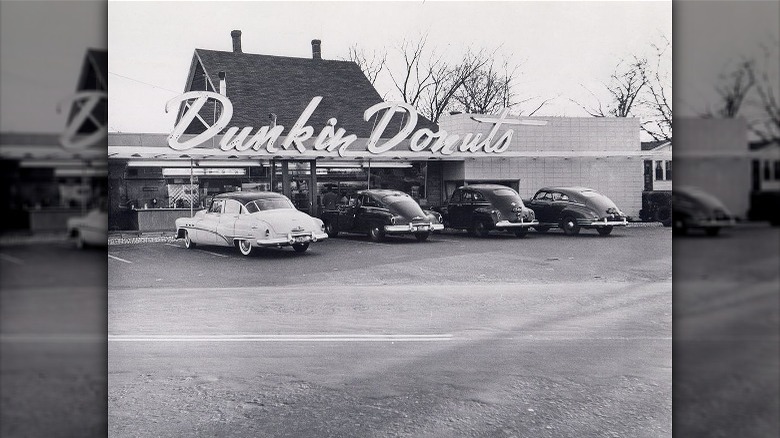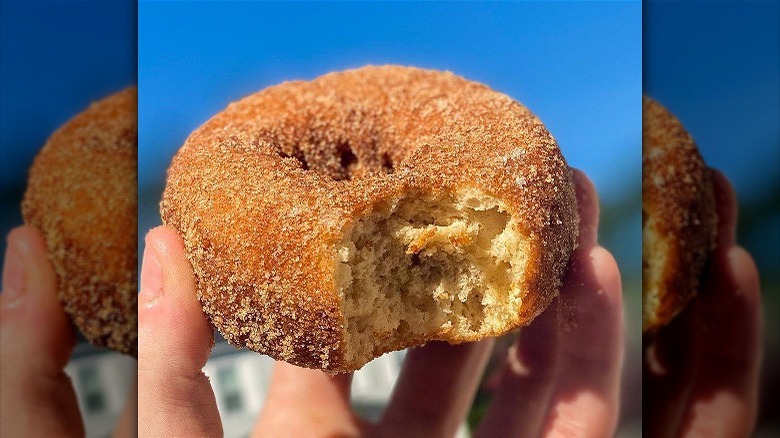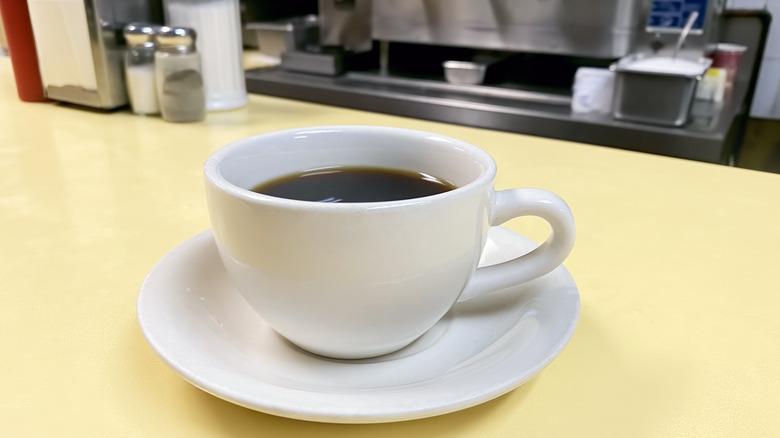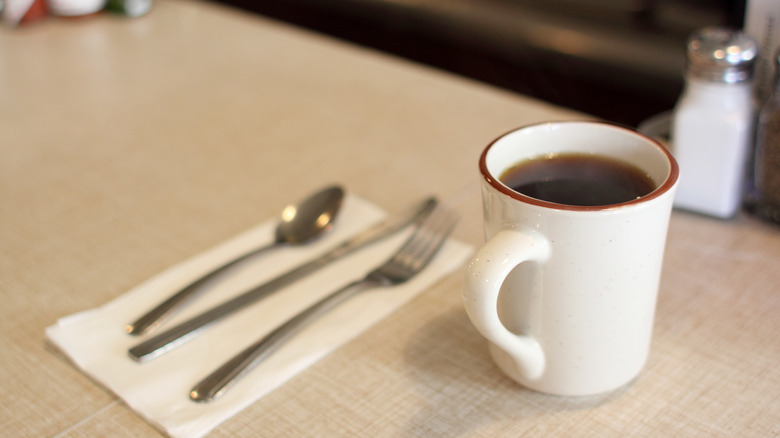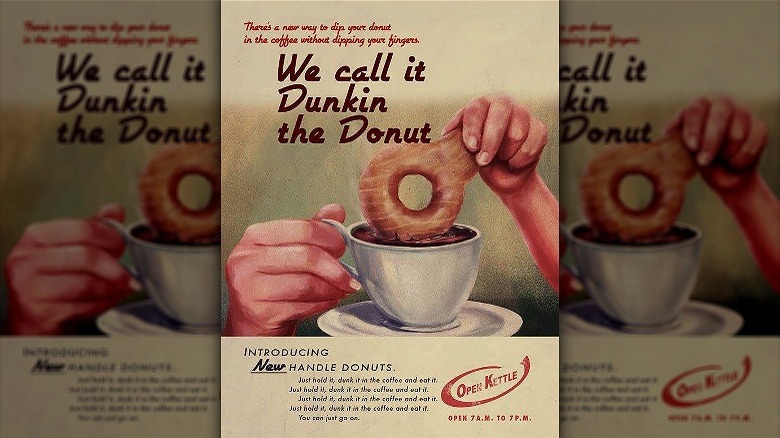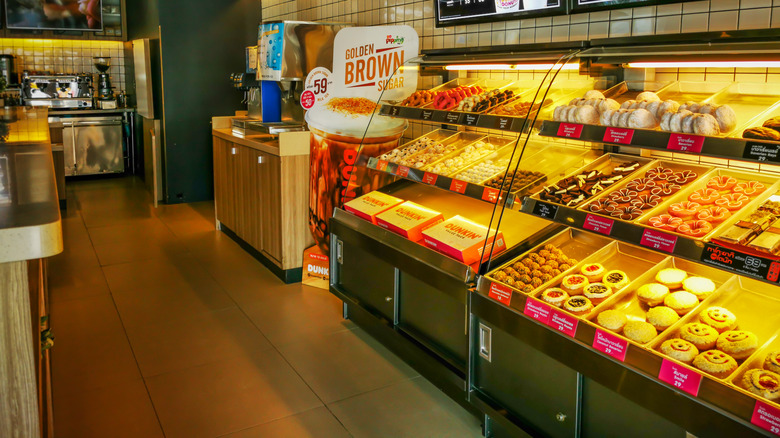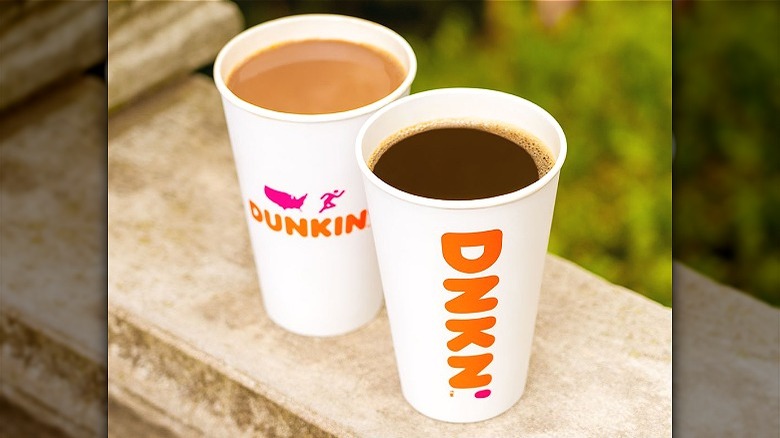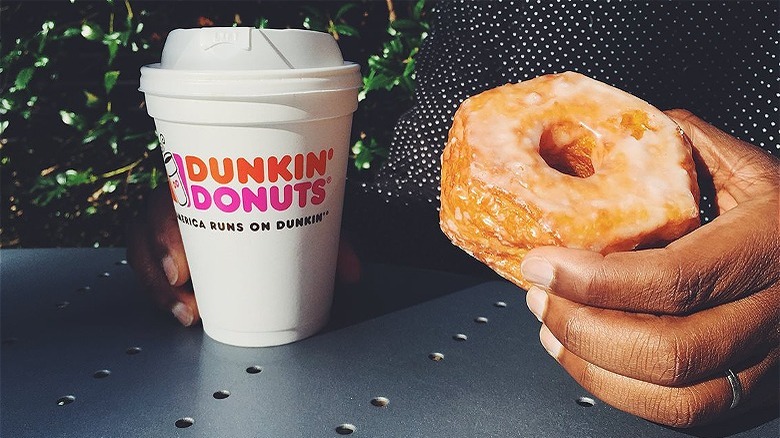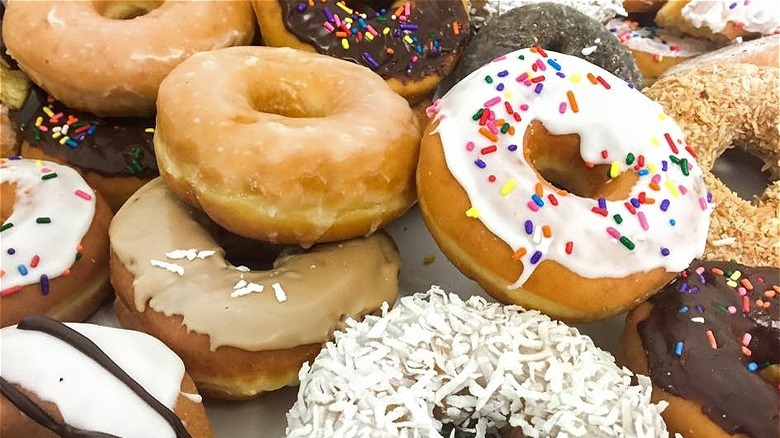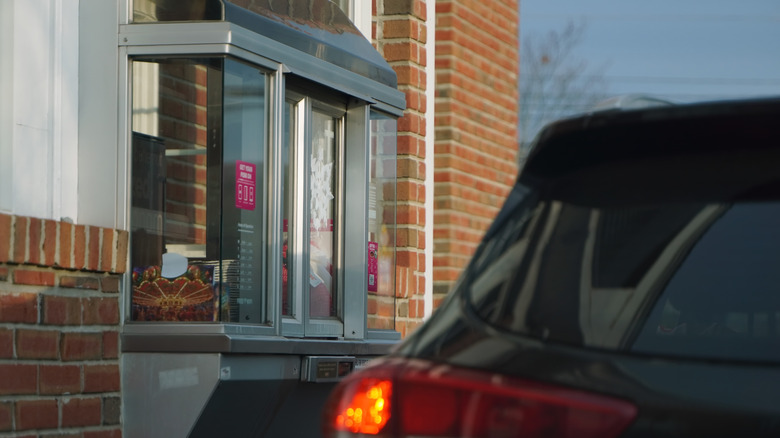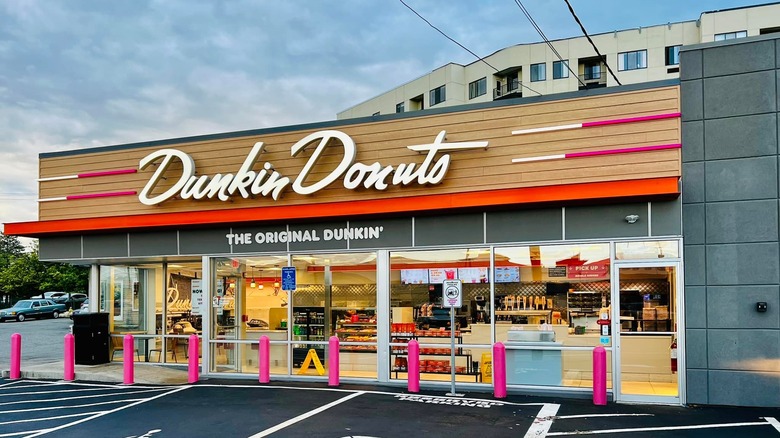The First Ever Dunkin' And What It Was Like To Eat There
America runs on it. New England adores it. Ben Affleck once worked at it (kind of). Dunkin' is its name, the doughnut and coffee juggernaut that has fueled millions — at a rate only beaten by a certain Seattle empire — with its warmth-inducing brews and sugary, sprinkled treats. Even dropping the doughy ring from its name, there's no mistaking it for anything else. There's doughnuts, sure, but the shop has dipped into food trends such as avocado toast, breakfast wraps, and hash browns — and should you feel so bold, snackin' bacon.
With more than 11,000 pink and orange shops spanning the globe, it's easy to forget that the coffee chain started on unfamiliar ground as a single shop in Massachusetts. William Rosenberg was the chain's founder, a rough-and-tumble entrepreneur who scavenged good ideas and business smarts throughout his youth wheeling through every odd job that came his way. He came to the conclusion that Bay Staters needed a coffee and doughnut shop, because as you're soon about to discover, it wasn't the type of thing Americans could just go to back then, the way we naively take for granted now.
So what was Dunkin' like before franchising, before the drive-thru, before the mobile app? Turn back the clock with us as we explore what it was really like grabbing a doughnut and coffee at the original, first-ever Dunkin'.
It opened in Quincy, Massachusetts
If Bostonians can agree on one thing, it's the place to go for their daily caffeine fix. But there was a time, however, when people wouldn't see a Dunkin' on every street corner in town. The coffee chain actually started in Quincy, Massachusetts, which is a suburb located south of Boston. In fact, it's dubbed the "City of Presidents" because of the long line of American statesmen who were born there. Among the most esteemed residents to hail from the area? John Adams, the country's second president, and founding father John Hancock.
William Rosenberg, who was born seven miles away in Massachusetts' Dorchester neighborhood, worked a series of entrepreneurial gigs in his youth. In 1948, he decided to launch a shop dedicated to only selling coffee and doughnuts, and the brick-and-mortar famously debuted during the Memorial Day Holiday on 543 Southern Artery. Although business was slow to catch on at first, we imagine plenty of locals were intrigued by the slap-dash little shop, taking advantage of the long weekend to see what it was all about.
Whether it's politics or fast food chains, American history wouldn't be what it is without discussing Quincy. It's the birthplace of the American experiment — and the doughnut and coffee shop one could say started it all.
Dunkin' went by a totally different name
When early patrons approached the new business on Southern Artery, the storefront's sign would have looked a lot different. Not just the design, mind you, but the name. That's because Dunkin' wasn't actually called Dunkin' at the time. No, when Rosenberg opened his shop from the ground-up it went by the name "Open Kettle." Unfamiliar? It's a reference to the process of making doughnuts — frying the fritters in a vat of oil, or the "open kettle," until golden-brown.
Certainly, the illusion made sense on paper. In practice, Open Kettle lacked the oomph needed to draw in customers who were slow to trickle through the doors as is, not to mention the ambiguity could confuse consumers on what exactly it was selling. So how did Rosenberg address the dilemma at hand? Banding together the brightest minds on his team, he tasked his business partners with creating a brand-new moniker for the company.
As the chain's lore reveals, it was Bernard Healy, who was hired by the store as an architect, that landed on the famous phrase Dunkin' Donuts. Healy's son recalled to Boston Magazine that the connection was a no-brainer. "My father said, 'What do you do with a chicken? You pluck it. What do you do with a doughnut? You dunk it.'" Hence, the Dunkin' Donuts American runs on was born, two years after opening its doors in Quincy, Massachusetts.
Doughnuts only cost a nickel
Can you think of anything in the U.S. that costs a nickel these days? Neither can we. Yet when Bay Staters started flooding an intriguing destination called Dunkin' Donuts back in 1950, five scents was all they'd pay for a doughnut. With inflation, that's about 62-cents apiece today. Considering modern consumers now spend around $1 to $2 per doughnut, customers could get a quick breakfast fairly cheaply. Heck, the price of one doughnut now would have easily covered a dozen back in the day, which cost 69-cents.
The Massachusetts paper The Republican published photos of a Dunkin' menu from this era, and it shows how customers might have spent more on doughnuts if they were a special variety. One section labeled "Deluxe Pastries" shows Twists and Strudels costing 13-cents each, a little over double what patrons would spend on a classic doughnut. They could also optimize their savings by purchasing a pair for a quarter.
Clearly, charging a nickel per doughnut — and similarly, a dime for coffee — hit the sweet spot for Dunkin's bottom-line. Even when it went by the ho-hum name Open Kettle, that didn't stop the fledgling operation from pulling in more than $1,000 after a single week doing business.
Customers sat at a counter with baked goods on display
For the first generation of Dunkin' customers, the Quincy store would have resembled a neighborhood diner more than any fast food joint around at the time. Not only was the dining space bigger in size, but the seating arrangement all but beckoned visitors to make it their morning hangout spot. Visitors could snag a stool from behind a curved countertop by the register, where a server stationed at the front would take orders, pour coffee from the pot, or retrieve pastries out of the display case nearby. It's the era of reading the daily paper while fueling up on a cup of Joe to start the day.
Another thing modern consumers will find so alien about Dunkin's original store was the attention to customer service it fostered. Quite frankly, the dynamic between employees and customers was a lot less impersonal. Chatting with your regular server or guest, depending on what side of the counter you took, was a common occurrence, according to Boston Magazine, and the bonds could be very tight-knit. Knowing your hostess by name hasn't gone away in the retail industry, but the sort of small-town feel found at Dunkin' back in the day — in our digital touch-screen world — seems so charmingly quaint.
Coffee was served in mugs
Dunkin' customers of yore were obviously encouraged to sit for a spell while they enjoyed their java, so what would they have drank it out of? A paper cup? A thermos? No, in the shop's infancy, visitors would have sipped out of porcelain mugs, filled on demand by the server manning the counter. There would be an eventual switch to disposable materials down the road, but in this era, the franchise used ceramic glassware to fuel its patrons.
There's something delightfully retro about fast food empires using real dishes, but there were of course downsides back when Dunkin' was a single establishment. Tom Schwarz, a former president for the doughnut chain, told Boston Magazine how much of a hassle ceramic cups were for a bustling cafe environment. Ceramics are fragile, for one, and any spilled coffee meant a shattered mess employees would have to clean up. If the store didn't replace mugs that had broken, they'd also have to make up for the ones visitors would regularly snatch from the store. William Rosenberg's son Bob Rosenberg attested to this occurring fairly regularly: "I was on radio talk shows getting calls from irate — I mean really irate — customers who didn't want to give up their coffee cup."
There was an actual Dunkin' Donut on the menu
Dunkin' was a trailblazer in countless ways. Besides the overwhelming bounty of sugary-sweet treats on display (more on that later), first-time clientele would have spied a particularly unusual goodie on the shelf that no other bakery had peddled in the city, let alone the country: a "Dunkin' Donut." Yes, the shop concocted a doughnut literally made for dunking, which Brand Eating reports William Rosenberg cooked up as a solution for avoiding the messy task of submerging a crumbly pastry into coffee. A cake variety equipped with a rounded tab, the idea was that customers could clutch onto the snack instead of leaving it to chance the way one did when dipping ordinary doughnuts into their drink.
Dunkin's decision to retire it in the early 2000s allegedly stemmed from the snack's labor-intensive process (and a ballooning menu), but in all honesty, it's not a shocking move given the doughnut's inefficient shape. Besides being arguably more cumbersome to handle, its wider circumference was reflective of the roomier mugs synonymous with its Post-War era as a counter-serve staple.
While not a slam-dunk by any means, the Dunkin' Donut is nonetheless an interesting footnote from the chain's past. If anything, the novelty on display would have delighted many original customers.
Doughnuts were made fresh in the store
To recall a time when doughnuts from Dunkin' were not only fresh, but made right on site at the shop? You'd have to have been a first-time follower of the chain going back to the mid-20th century to taste them for yourself — and back then, they were a treat. Contrary to the mass-produced batches of baked goods that are shipped out of a core factory to surrounding regions, at one point Dunkin' ran like a real bakery, with real bakers rolling out the dough and frying the rings from scratch in the kitchen. And to the lucky bystanders who were able to witness it, the scent of sugary-sweet goodness that trailed out from the store was like heaven on earth.
Now, William Rosenberg was a bonafide stickler in all matters of quality control, and under his watch, doughnuts weren't simply a product to move willy-nilly — they had to live up to the highest of expectations. As in, no stale day-olds. According to the University of New Hampshire, the shop's policy required workers to toss out any doughnut that had been left out on the shelf longer than five hours. Keeping a steady flow of fresh confections was the goal, and for first-time fans looking back, it was something you could really appreciate about Dunkin'.
There were only two ways to order Dunkin' coffee
Dunkin's beverage menu is chock-full of choices, from brain-freezing Coolattas and cold brew to matcha and chai tea. To call Dunkin's selection "simple" when it was merely chugging along on 543 Southern Artery would be an understatement, because really, there was little variety. In 1950, the only beverage on the menu was coffee, and patrons seeking out a cup would have encountered few ways to order it. Want a hint? There would not have been almond milk or hazelnut syrup, nor the multitude of roasts beyond the house blend. We're talking bare-bones, no-frills, fuel-up brew straight from the pot.
Basically, there were two options the hostess would give you, and you could take 'em or leave 'em. You could either skip the caffeine by getting decaf, or you could jazz up your morning cup with cream and sugar, otherwise known in New England parlance as "regular." In many ways Dunkin' hasn't deviated much from its roots. The proprietary roast Dunkin' developed at its launch has never changed, while the cream's generous amount of butterfat was what visitors would have received at an upscale inn, not a casual diner.
This might not have been the most exciting lineup in the world, looking back, but when Dunkin's whole deal was serving coffee and doughnuts, well, nobody could accuse it of false advertising.
Dunkin' only served coffee and doughnuts
Seeking out a breakfast that wouldn't put them in a sugar coma just wasn't in the cards for early Dunkin' patrons. It was coffee and doughnuts, nothing more, nothing less. Long before the rise of wraps and sandwiches, let alone sweeter alternatives like muffins, this combination was virtually all anybody could buy when the franchise first started. For fan-favorites that are ubiquitous to the chain's success today, you would have had to wait a few decades after its debut. Munchkin doughnut holes, as an example, wouldn't become a thing until the 1970s.
Prioritizing these two products in particular wasn't exactly done on the fly. As a matter of fact, Dunkin's focus on coffee and doughnuts emerged from William Rosenberg spotting a noticeable hole that wasn't filled in the retail environment at the time. During one of the founder's first entrepreneurial ventures feeding construction workers out of a mobile food truck, the combo proved to be a big driver of business — 40% of the business' earnings, to be exact. People went wild over the pairing, as the story goes, and it eventually lead the burgeoning tycoon to dedicate an entire concept to it. It's convenient and complimentary, a winning combination.
There were a lot of doughnuts to choose from
Before Dunkin' hit the scene, consumers would have endured the same delicious, albeit limited selection of doughnuts. Plain cake, glazed, and French Crullers were among the typical varieties, but William Rosenberg wasn't satisfied with the status quo. So what did he do? Why, he bumped up the number of pastries (52, to be exact) and generated new flavors rarely seen in bakeries of the era. Suddenly, customers had a slew of options to choose from, and the choice could be deliciously overwhelming.
Rosenberg's approach, Mass Moments writes, allegedly came from a local ice cream brand called Howard Johnson which was known for scooping 28 different flavors in its shops. Not only did Dunkin' serve double the options of doughnuts, the amount meant patrons could theoretically sink their teeth into a unique treat every week for an entire year. Among the fritters that were on display to Quincy residents would have been specialties like Boston Creams, rings with chocolate and vanilla icing, sprinkles, and an array of jelly fillings — think lemon and strawberry, as well as less typical flavors like pineapple and black raspberry.
The company's scaled back its doughnut offerings in recent years, so even by 2023's standards the original Dunkin' would have been impressive to everyone.
There wasn't a drive-thru
A large chunk of Dunkin's revenue flows from the drive-thru, but believe it or not, the company didn't start out that way. Travel back to the post-War era that produced the doughnut empire, and you'll see that there was no drive-thru window. At the Quincy shop, locals looking for a quick bite would have to physically leave their cars and step inside the shop to order any food, and that's assuming they were able to squeeze their vehicle into the cramped patch of asphalt that constituted a parking lot.
Make no mistake, the drive-thru as a concept was already revving its gears prior to Dunkin' changing its name from Open Kettle. Money reports that eateries like Red's Giant Hamburg and In-N-Out Burger had begun implementing pick-up lanes in the late 1940s. This means the public was somewhat familiar with the service method, if not shifting their dining habits by ordering directly from the car were the option available to them. But as the National Museum of American History demonstrates, the technology's newness didn't catch on right away. Drive-thrus would go on to fuel hungry customers in the future, but Dunkin' was far from rooted in the past. Presumably, the shop stayed true to the norms of its time.
The first-ever Dunkin' is still in business today
Die-hard Dunkin' fans should not hesitate to put the first-ever location on their bucket list. If you find yourself bopping around Quincy, MA, you can go see the original shop standing in the same spot on 543 Southern Artery, where it opened that fateful Memorial Day weekend more than 70 years ago. What's more, the store's been refurbished to mimic an almost-identical appearance to what it looked like in the past, right down to the cursive scrawl of the exterior sign.
Of course, there's nothing terribly unique about the flagship, in the sense that it doesn't sell any food or drinks you couldn't find at the thousands of other stores across the country. That being said, when it underwent a remodel in 2022 to add old-school flourishes like the countertop and stools, locals were pretty delighted that they could experience the doughnut shop authentically, or in the case of one patron, actually re-claim their seat once again. Additionally, the walls were adorned with photos from the chain's past, letting customers become immersed in the logos, mascots, and menus that defined the shop all those years ago. It's a blast from the past and, quite frankly, shows how far Dunkin's come as an American icon.
